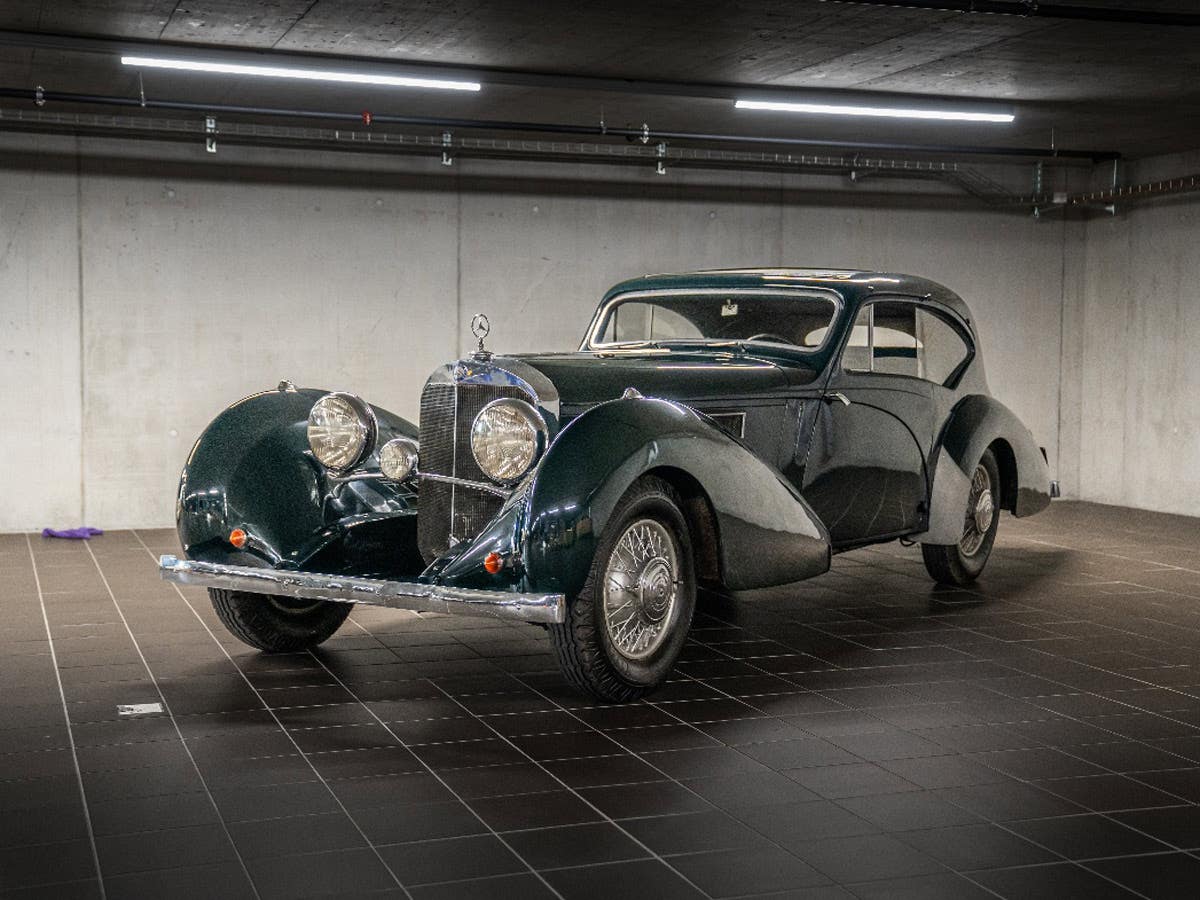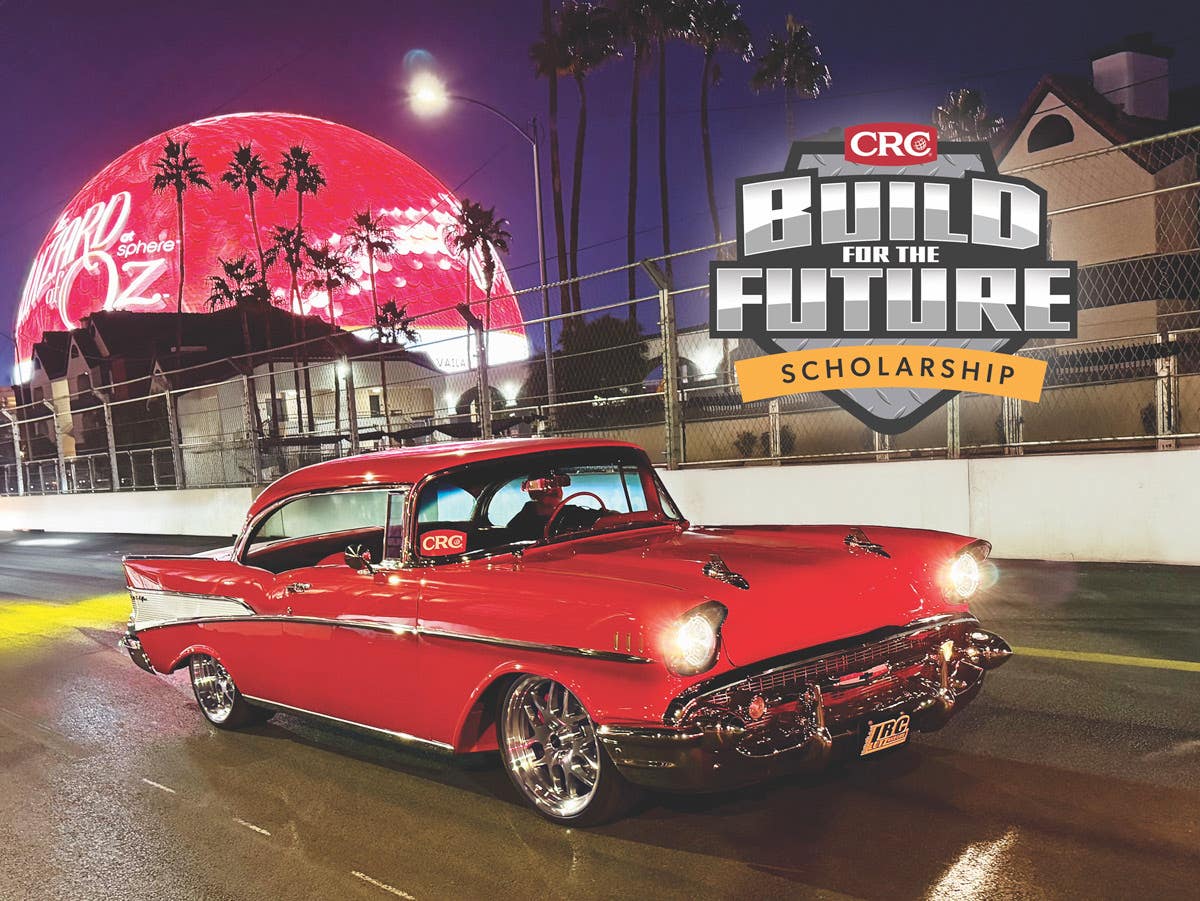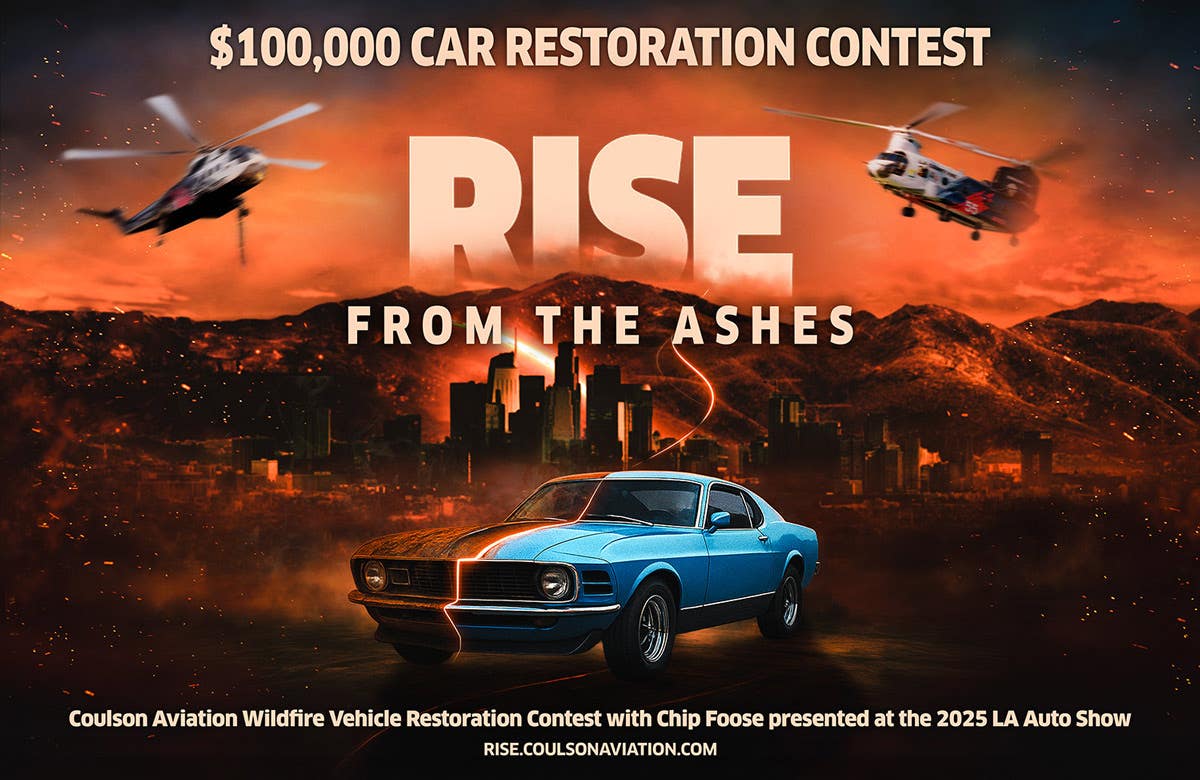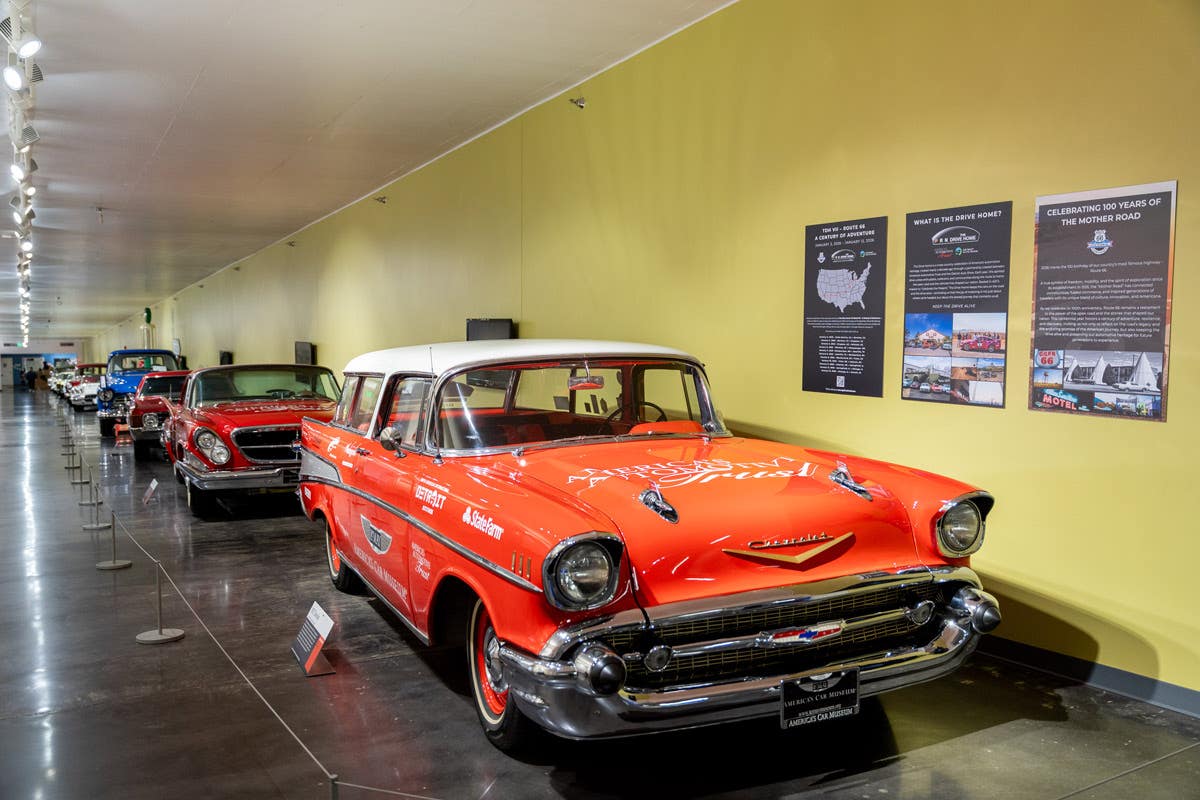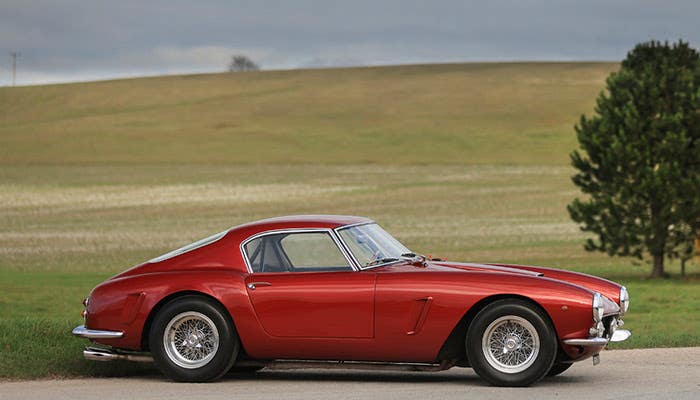The prevailing tone for the 2007 New York International Auto Show was pretty much set two days before press previews began. At that time, the U.S. Supreme Court rebuked carmakers and the Bush administration with a 5-4 ruling that carbon dioxide and other greenhouse gases should be regulated as pollutants under the Clean Air Act.
J Mays (center), the Ford Motor Co.'s group vice president for design, discusses the 40th anniversary Shelby GT 500 KR with two admirers at the 2007 New York International Auto Show. Packing 540 hp, its 5.4-liter supercharged V-8 is the mightiest ever used in a production Mustang.
To further ensure the point was not ignored, activists from the Freedom From Oil campaign scaled the entrance of the Jacob Javits Convention Center to hang a banner vilifying the new, bigger Toyota Tundra pickup and its advertising slogan "The Truck That's Changing it All." The group's replacement banner crossed out the last two words in Toyota's banner to read, "The Truck That's Changing the Climate." Though these Spider-Man wannabes were quickly taken into custody by police using a cherry-picker, the spectacle must have pleased the hippies who picketed the auto show's opening on an almost-annual basis during the 1960s and '70s!
The exhibits inside Javits, open to public scrutiny April 6-15, hardly turned away from size or power in response, but the references to increased fuel efficiency found in even the press materials for the Hummer H2 and the 560-hp Callaway C16 Corvette marked a pronounced trend towards delivering such attributes.
"The idea of not relying on one power source is starting to resonate with the public," observed Mark Schienberg, president of the Greater New York Automobile Dealers Association that sponsors the show. "Running emissions-free is not alien to the YouTube and MySpace generation. Our goal is to remove any fear consumers might have about the new technology."
Todd Yoriano, a GM district service manager from eastern Long Island, joins his 7- and 10-year-old sons Alexander and Daniel as they admire the 1967 Chevrolet Astro I concept that witnessed its world debut at the 1967 New York International Auto Show. A rooftop periscope afforded rearward vision in the absence of a window, while the rear-hinged entry canopy originally lifted the seats off the floor into an "astronaut-type" position.
Starting with the very first press conference the morning of April 4, General Motors embraced the small-is-beautiful idea with three Korean-designed Chevrolet micro-car concepts dubbed the Beat, Groove and Trax (the press was urged to toss color-coded Nerf balls on-stage to elect their favorite, while the public can do likewise at www.vote4chevrolet.com).
Buick staged a lower-key revival of the Super badge it used from 1940-'58, launching a mid-sized LaCrosse Super powered by a 300-hp, 5.3-liter V-8 with computerized cylinder deactivation, and a larger Lucerne Super touting traditional front fender VentiPorts and a high-output, 292-hp version of the 4.6 liter Northstar V-8.
Torrential rain did not deter DaimlerChrysler's product development chief Frank Klegon from demonstrating the full-length, Sky Slider sunroof on the all-new 2008 Jeep Liberty. Its canvas can be opened from front-to-back or vice-versa, while anti-pinch software prevents the roof from moving if there's an umbrella or other object in its path.
Heavy rain was an unwanted effect at the outdoor volcanic eruption that unveiled the all-new 2008 Jeep Liberty, but DaimlerChrysler development chief Frank Klegon pressed on regardless, declaring "we have a plan for everything" as an umbrella popped out of the optional full-length Sky Slider sunroof. The vehicle's many other enhancements, including independent front suspension and a longer, wider interior with a fold-flat front passenger seat, were still overshadowed by DaimlerChrysler AG Chairman Dieter Zetsche's nearly simultaneous confirmation, at the annual shareholders' meeting in Berlin, Germany, that the Chrysler unit is for sale.
The New York auto show's Taxi 07 exhibit also featured this purpose-built design being developed for 2008 production by Standard Cabs of Northbrook, Ill., which is fully ADA-compliant with its 56-inch-tall door openings and slide-out wheelchair ramp. The fenders are bolt-on and identical right-front-to-left-rear and left-front-to-right-rear, while its flat-floored, 26-cubic-foot trunk can fit four golf bags, four overnight suitcases and a full-sized spare tire.
Like Chrysler, Ford's Job One at Javits was to emphasize it had a future, and CEO Alan Mullaly certainly got off on the right foot with a remarkable, entirely spontaneous speech to the International Motor Press Association's annual breakfast. His speech was delivered without a podium, Teleprompter or even written notes. Dearborn's production debuts were similarly promising, starting with a supercharged, 540-hp Shelby GT 500 KR that will be the most powerful-ever production Mustang when 1,000 coupe versions hit the streets next spring. While it was officially termed a crossover like the smaller Edge and Taurus X, the 2009 Flex might make station wagons cool again with its chopped roof, ribbed body sides and aluminum tailgate trim echoing the three-bar grille being phased in as Ford's "family" face.
"As for wood paneling, we checked it out and we discarded it," the company's group vice president design and chief creative officer J Mays recalled in a one-on-one interview after the launch. "I don't want to do retro. The ribs milled into the doors allude that there used to be wood paneling here." Dispensing with sliding rear doors and its minivan stigma, meanwhile, freed up funds for better-quality leather, removable footrests and novel options like a glass Vista Roof and a class-exclusive refrigerator mounted between the second row captain's chairs. Though Mays also stressed that the Flex "is about the East Coast, and the Hamptons ' anyone on Polo.com looking for a sweater is going to like this," California customer Chip Foose declared that he "would love to get one for SEMA this year or next. I think that car is just right for the aftermarket industry. That's the mature Scion."
Featured in a special exhibit celebrating the 100th anniversary of New York City's first gasoline-powered taxi, this 1956 Checker A8 owned by Bruce & Marjorie Uhrich of Glenside, Pa., is one of only four known survivors out of thousands built. "Two are restored," Bruce adds, "mine in the New York City yellow-and-green colors and the other in Chicago colors of green-and-cream; it's owned by Joe Fay, a former Checker Car Club President."
Evoking how the first New York International Auto Shows in the 1 950s helped establish their East Coast beachheads, European carmakers put on the Ritz with the North American debuts of the Bentley Brooklands (honoring the centenary of the fabled British racing circuit) and Pininfarina-designed Maserati GranTurismo coupes, as well as a wild orange Lamborghini Gallardo V-10 "Superleggera" weighing 154 pounds less than the standard model.
Announcing that just 40 will be sold worldwide, Mercedes feted the 40th birthday of the performance-tuner AMG with a special-edition CL65 coupe sporting "liquid metal" paint and a 612-hp twin-turbo V-12, while Volvo's second-generation XC70 station wagon upped the safety ante with automatically locking under-floor storage and laminated glass for all windows.
Renowned Corvette modifier Reeves Callaway met his wife Sue (an editor at Fortune magazine) when he unveiled his C12 at the 1998 New York International Auto Show. It was therefore fitting that he would stage the world debut of his C16 Cabriolet in the exact same spot in the Crystal Palace nine years later.
After only two years in showrooms, the Subaru Tribeca SUV swapped its "horse collar" grille for a far less-polarizing egg-crate recalling the Chrysler Pacifica, while the all-new 2008 Impreza and WRX moved to a shortened Legacy platform yielding more interior space, bigger door openings and fully framed side glass for reduced wind noise.
Spectators who valued pedigree over novelty were treated to a 22,000-square-foot Heritage & Horsepower exhibit that was the largest vintage car assemblage seen at Javits since the show's centennial in 2000. Despite worthy competition from the Bulgari Collection's 1931 Chrysler CG1 Imperial dual-cowl phaeton and a 1940 Buick Super Estate Wagon that Warner Brothers gave to Bette Davis after its appearances in "Now, Voyager," "White Heat" and other films, the undisputed star of this display was the Chevrolet Astro I that originally debuted at the 1967 New York International Show. With its two seats accessed by a rear-hinged, periscope-topped canopy, this still-stunning concept from the GM Heritage Collection was only half as tall as the adjacent 1936 Cadillac V-12 Fleetwood coupe brought from Tacoma, Wash., by the Harold E. LeMay Museum.
Falling on Saturday, April 14, Volvo's 80th anniversary was celebrated at the New York show with this 1927 PV4 "Jakob" fitting a 20 hp, four-cylinder engine and a leather-covered sedan body with cowl-mounted trafficators. One of only 297 cars built in Goteborg that first year, it was originally registered to a school inspector in Orebro, Sweden, and restored by Volvo Cars of North America in 2001.
An entirely separate exhibit celebrating the 100th anniversary of New York City's first gasoline-powered taxi featured Bruce and Marjorie Uhrich's 1956 Checker A8 from Glenside, Pa., which is one of only four known and two fully restored survivors out of the thousands built. Found by fellow Checker enthusiast Bill Hossfield in a northern New Jersey wrecking yard, Bruce recalled that the body was extremely rusty, but "all the parts were there" and it still had its original 226-cid Continental Red Seal L-head six-cylinder engine.
"Checker started using [the Continental engine] in the 1930s and kept it until they switched to Chevrolet power in 1962," he continued, adding that "they still make the engine today for forklifts." A full restoration, lasting from 1999-2005, was supervised by Mark Szpanka of Legendary Automotive in Hatboro, Pa., who added "the hardest part was matching the brakes and other components to whose parts Checker used. The ball joints and tie rods are Ford items, while the steering is Bendix like a Studebaker and the transmission is from Borg-Warner. The rear end cover was the same as the one on a new Dodge truck."
With its spacious, squared-off body and roll-out wheelchair ramp emerging from 56-inch-tall rear door openings, another big attention-getter in the Taxi 07 exhibit was the purpose-built Standard Taxi that The Vehicle Production Group LLC of Northbrook, Ill., is developing for sales of 12-15,000 units annually, at a cost of around $25,000 each, by 2008.
"We brought in fleet owners and asked them what the perfect taxi would be," explained design team member Kabe Morphew, who elaborated that "one of the things they wanted was space for four passengers (in the rear), with enough luggage room for four golf bags and four overnight suitcases. So we gave them a 26-cubic-foot trunk with a flat floor and a full-sized spare tire. We made the body go straight up and down to maximize interior space for the passengers."
Though the exterior is 14 inches shorter than that on a Ford Crown Victoria taxi, the body is an inch-and-a-half wider and "a wheelchair can face forward or back in the space next to the driver ' you can even drive a scooter inside." Power comes from a General Motors 4.3-liter V-6 that has already proven itself in taxi service, and Morphew said "it's also our intention to make CNG and LPG powerplants available from the factory." Marc Klein, the president of Standard Cabs, added that "The Markin family [who designed and sold the original Checker taxi] saw the concept a couple of months ago and they loved it."



